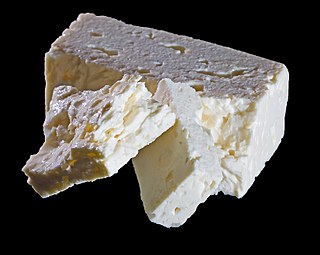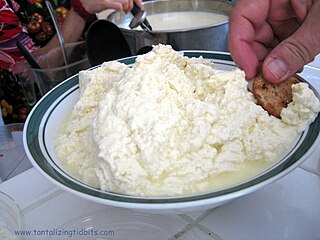
Mozzarella is a semi-soft non-aged cheese prepared by the pasta filata method with origins from southern Italy.

String cheese is any of several different types of cheese where the manufacturing process aligns the proteins in the cheese, which makes it stringy.

Feta is a Greek brined white cheese made from sheep's milk or from a mixture of sheep and goat's milk. It is soft, with small or no holes, a compact touch, few cuts, and no skin. Crumbly with a slightly grainy texture, it is formed into large blocks and aged in brine. Its flavor is tangy and salty, ranging from mild to sharp. Feta is used as a table cheese, in salads such as Greek salad, and in pastries, notably the phyllo-based Greek dishes spanakopita "spinach pie" and tyropita "cheese pie". It is often served with olive oil or olives, and sprinkled with aromatic herbs such as oregano. It can also be served cooked, as part of a sandwich, in omelettes, and many other dishes.

Potato pancakes are shallow-fried pancakes of grated or ground potato, matzo meal or flour and a binding ingredient such as egg or applesauce, often flavored with grated garlic or onion and seasonings. They may be topped with a variety of condiments, ranging from the savory, to the sweet, or they may be served plain. The dish is sometimes made from mashed potatoes to make pancake-shaped croquettes. Some variations are made with sweet potatoes.

Goat cheese, goat's cheese or chèvre is cheese made from goat's milk. Goats were among the first animals to be domesticated for producing food. Goat cheese is made around the world with a variety of recipes, giving many different styles of cheeses, from fresh and soft to aged and hard.

Ricotta is an Italian whey cheese made from sheep, cow, goat, or Italian water buffalo milk whey left over from the production of other cheeses. Like other whey cheeses, it is made by coagulating the proteins that remain after the casein has been used to make cheese, notably albumin and globulin.

Podhale, sometimes referred to as the Polish Highlands, is Poland's southernmost region. The Podhale is located in the foothills of the Tatra range of the Carpathian mountains. It is the most famous region of the Goral Lands which are a network of historical regions inhabited by Gorals.
Romanian cuisine is a diverse blend of different dishes from several traditions with which it has come into contact, but it also maintains its own character. It has been mainly influenced by Turkish but also a series of European cuisines in particular from the Balkan Peninsula and Hungarian cuisine as well as culinary elements stemming from the cuisines of Central Europe.

Bryndza or brynza is a sheep milk cheese made across much of East-Central Europe, including in Ukraine and Slovakia. Bryndza cheese is creamy white in appearance, known for its characteristic strong smell and taste. The cheese is white, tangy, crumbly and slightly moist. It has characteristic odor and flavor with a notable taste of butyric acid. The overall flavor sensation begins slightly mild, then goes strong and finally fades to a salty finish. Recipes differ slightly across countries.

Bundz - also known as bunc(Podhale dialect) and budz is Polish and Ukrainian and Goral sheep milk cheese. It is traditionally produced in Polish mountains - Bieszczady, in Podhale and Ukraine.

Telemea is the name of a Romanian cheese traditionally made of sheep's milk. Nowadays the term encompasses cheese made out of cow's milk, and in some cases of goat's, or buffalo's milk.

Traditional Kazakh cuisine is the traditional food of the Kazakh people. It is focused on mutton and horse meat, as well as various milk products. For hundreds of years, Kazakhs were herders who raised fat-tailed sheep, Bactrian camels, and horses, relying on these animals for transportation, clothing, and food. The cooking techniques and major ingredients have been strongly influenced by the nation's nomadic way of life. For example, most cooking techniques are aimed at long-term preservation of food. There is a large practice of salting and drying meat so that it will last, and there is a preference for sour milk, as it is easier to save in a nomadic lifestyle.

Oštiepok is a traditional smoked sheep milk cheese made in Slovakia. Oštiepok is a protected trade name under the EU's protected geographical indication.

Parenica is a traditional Slovak cheese. Parenica is a semi-firm, non-ripening, semi-fat, steamed and usually smoked cheese, although a non-smoked version is also produced. Parenica is cream and yellow in color, which is darkened by steaming. The cheese is produced in strips, which are woven into snail-like spirals. Originally, about two centuries ago, it was made from pure non-pasteurized sheep's milk. Modern varieties are also produced from cow's milk or milk mixtures. Typical cheese rolls weigh about 100 grams.

Redykołka is a type of cheese produced in the Podhale region of Poland. It is sometimes known as the "younger sister" of the Oscypek cheese and the two are occasionally confused. The similarity comes from the fact that redykołka is traditionally made using leftover Bundz from Oscypek production.

Kopanisti is a salty, spicy cheese, with protected designation of origin (PDO) produced in the Greek islands of the Cyclades in the Aegean Sea such as Mykonos, Tinos, Andros, Syros, Naxos etc.; it has been produced in Mykonos for more than 300 years. It owes its special peppery and spicy taste to rapid and extensive lipolysis and proteolysis caused by abundant microbial growth encouraged by repeated kneadings performed during the ripening process.

Sheep milk cheese is a cheese prepared from sheep milk. Well-known cheeses made from sheep milk include the feta of Greece, Roquefort of France, manchego from Spain, the pecorino romano and ricotta of Italy. Yogurts, especially some forms of strained yogurt, may also be made from sheep milk.

















